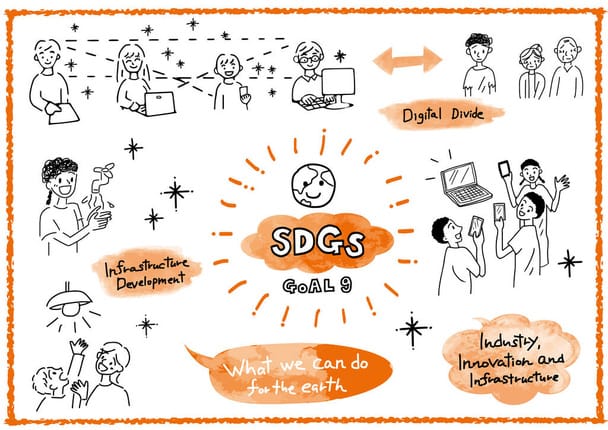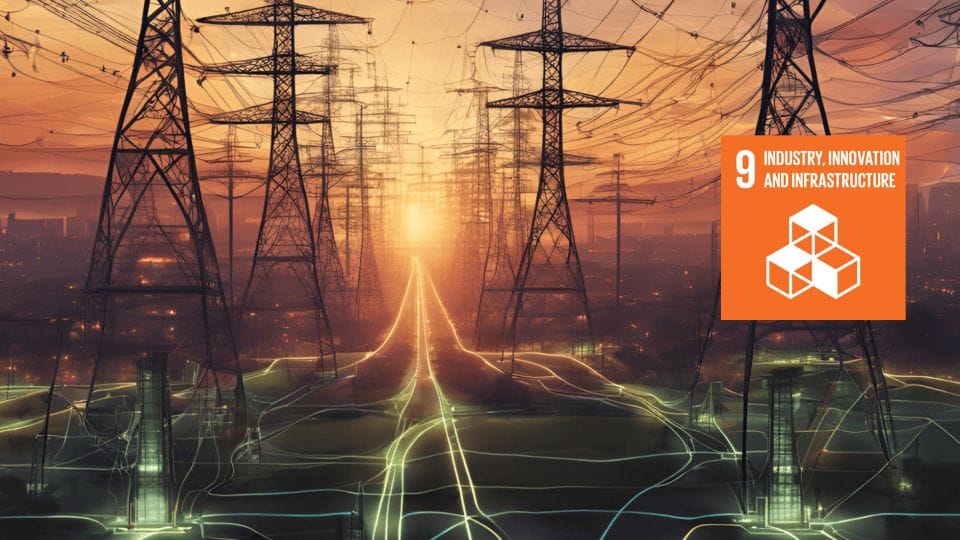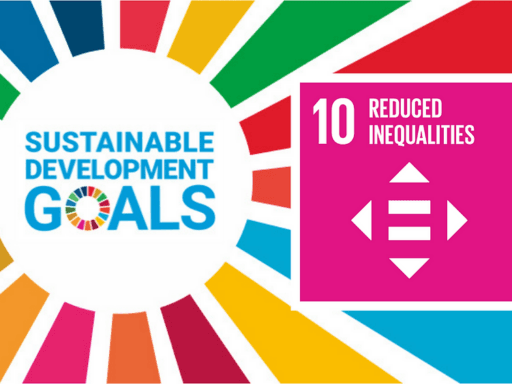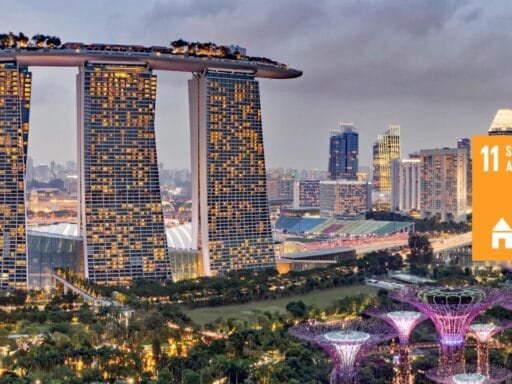Sustainable Development Goal 9 (SDG goal 9) focuses on supporting inclusive and sustainable industrialization, stimulating innovation, and developing resilient infrastructure. These three interrelated pillars are critical for driving economic development, decreasing disparities, and tackling important global issues like climate change and poverty. SDG goal 9 aims to boost productivity, accelerate growth, and build a sustainable future by investing in robust infrastructure, creative technical solutions, and industrial breakthroughs.
The United Nations’ Sustainable Development Goal 9, or SDG 9, aims to construct resilient infrastructure, boost innovation, and promote inclusive and sustainable industrialization. It serves as a foundation for establishing economically stable communities, producing productive jobs, and promoting technological progress. By connecting global economic operations with environmental and social sustainability, SDG Goal 9 is critical to fostering sustainable development across nations.
The Importance of SDG Goal 9
SDG goal 9 emphasizes infrastructure, industry, and innovation as critical components of economic growth and development. Investing in robust infrastructure such as transportation, electricity systems, and digital connection boosts productivity while also improving marginalized people’ access to key services. The significance of SDG goal 9 goes beyond physical structures. Encouraging innovation within sectors improves long-term economic growth, reduces disparities, and accelerates technical advancement. This 9th goal aims to provide equitable opportunities for everyone by overcoming technology disparities and contributing to climate change mitigation through cleaner technologies.
Understanding SDG Goal Industry, Innovation, and Infrastructure
SDG Goal 9 is a multifaceted strategy that aims to promote innovation while modernizing global infrastructure and industries. Let’s examine its main aspects:
- Industry
Economic expansion and the generation of jobs depend on industrialization. By giving sustainable industrial growth first priority, nations can lower poverty, increase GDP, and promote equitable economic opportunity. Reducing carbon emissions, implementing circular economy models, and practicing environmentally sensitive business are the main goals of sustainable industries.
- Innovation
By developing fresh approaches to problems in the social, environmental, and economic spheres, innovation acts as a catalyst for change. Innovation promotes increased efficiency and adaptability, as seen in developments in smart technologies and renewable energy.
- Infrastructure
Both economic productivity and social well-being depend on strong infrastructure. Equitable access to services, economic connectedness, and a reduction in inequality are made possible by resilient transportation infrastructure, dependable energy, clean water, and telecommunications networks.
Importance and History
Reaching SDG Goal 9 lowers poverty and inequality by promoting inclusive economic growth and ensuring fair access to resources. It encourages a robust economy, boosts competitiveness, and creates jobs, which results in financial stability and social empowerment. The goal’s dedication to innovation also tackles urgent global concerns like socioeconomic disadvantage, technical disparities, and climate change.
In order to eradicate poverty, safeguard the environment, and guarantee prosperity for all, the United Nations approved the 2030 Agenda for Sustainable Development in 2015. SDG goal was established to address global inequalities in infrastructural access, technical innovation, and industrialization. Economic disparity, the speed at which technology is developing, and growing concerns about climate change make it imperative that sectors embrace creative solutions for long-term, sustainable growth.
Targets and Indicators
SDG Goal 9 lays out a number of precise benchmarks that direct international efforts to meet its goals. Important goals consist of:
- Create Dependable, High-Quality Infrastructure. Encourage resilient infrastructure that is inclusive, sustainable, and able to improve both human well-being and economic prosperity.
- Encourage Sustainable and Inclusive Industrialization. Promote a notable rise in the industry’s GDP and employment share.
- Modernize Infrastructure and Retrofit Sectors. Reduce resource consumption, lessen environmental damage, and increase resource efficiency by implementing and upgrading technology.

Challenges in Achieving SDG Goal 9
While the targets of Industry, Innovation, and Infrastructure are ambitious, achieving them presents a range of challenges:
- Lack of Funding: The money required to construct or improve infrastructure is frequently lacking in developing nations. To provide fair access to essential services, investments are needed.
- Technological Inequalities: Advancement is hampered by the differences in industrialized and developing countries’ technological capacities. It takes concentrated efforts, such as technology transfer and digital literacy initiatives, to close the digital divide.
- Environmental Degradation: Pollution and resource depletion are two issues brought on by industrial activity. It is essential to strike a balance between sustainability and industrial progress.
- Workforce Skills Gap: New breakthroughs and emerging industries need for a workforce with the skills to adjust to changing demands and technologies. This calls for funding for reskilling, training, and education initiatives.
Practical Steps for Advancing SDG Goal 9
By using realistic, cooperative tactics, the international community may hasten the achievement of SDG goal which is about Industry, Innovation, and Infrastructure:
- Investing in R&D
Giving research and development (R&D) a priority can spur technological improvement and innovation, tackling global issues and promoting inclusive growth.
- Constructing Infrastructure That Is Resilient
To encourage connectivity and fair access to basic services, governments must make investments in electricity, water, and transportation infrastructure.
- Promoting Public-Private Collaborations
Governments, corporations, and civil society working together can stimulate innovation, gather resources, and promote sustainable industrialization.
Case Studies of SDG Goal 9 in Action
Case Study 1: Germany’s Transition to Smart Industry
The idea of “Industrie 4.0,” which combines automation, digitalization, and sophisticated manufacturing technology, has been adopted by Germany. Germany’s manufacturing sector is now very inventive, efficient, and sustainable because to collaborations between industry, academia, and the government. Global competitiveness has improved, waste has decreased, and productivity has increased as a result of this shift.
Case Study 2: Kenya’s Mobile Innovation Revolution
Economic inclusion and access to financial services have been transformed by Kenya’s development of mobile payment systems like M-Pesa. Through the use of digital innovation, Kenya has increased low-income and rural areas’ access to banking, empowering millions of people and strengthening the national economy.
Case Study 3: Morocco’s Renewable Energy Initiative
Morocco’s use of renewable energy alternatives has advanced significantly. By 2030, the nation hopes to have more than half of its energy come from renewable sources thanks to investments in hydroelectric, wind, and solar projects. Morocco’s dedication to sustainable industrialization, lowering reliance on fossil fuels, and fostering green jobs is demonstrated by this program.
FAQs
1. What is SDG Goal 9?
This SDG’s 9th goal focuses on building resilient infrastructure, promoting inclusive industrialization, and fostering innovation.
2. Why is SDG Goal 9 important?
It drives economic growth, addresses social inequalities, promotes environmental sustainability, and enhances global technological advancements.
3. How can businesses contribute to SDG Goal 9?
Businesses can invest in sustainable industrial practices, upgrade infrastructure, promote innovation, and offer equal job opportunities.
4. What are the main challenges in achieving SDG Goal 9?
Challenges include funding gaps, unequal technology access, and building climate-resilient infrastructure.
5. How does Fherist support SDG Goal 9?
Fherist offers sustainable business solutions, fosters innovation, and promotes corporate transparency to align with 9th goal of SDG.
Services Provided by Fherist
Fherist provides a variety of services aimed at assisting in the accomplishment of SDG objective 9. They contributes significantly to the advancement of infrastructure development and industry innovation by offering tools and resources for digital transformation, sustainable business practices, and transparent corporate operations. Businesses who partner with Fherist can access a network of professionals and cooperative opportunities, advancing the development of a just and sustainable global economy.
Conclusion
Promoting economic growth, sustainable industrialization, and fair access to technology all depend on SDG objective 9, which focuses on industry, innovation, and infrastructure. Collaboration, innovation-driven policies, and sustainable investments that benefit the environment, society, and global economy are all necessary to achieve this aim. We can all have a better, more sustainable future if we establish inclusive sectors, promote innovation, and build resilience.








